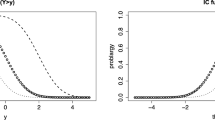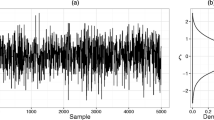Abstract
In line with the latent trait model, the continuous response level is defined and considered, in contrast to the discrete response levels, which have already been explored by the author. Discussions are mainly focused on the homogeneous case and the open response situation. The operating density characteristic of the continuous item score is defined. Also the basic function, information functions and the positive-exponent family are discussed on the continuous response level, in connection with the sufficient condition that a unique maximum estimate is provided for the response pattern, which consists of the continuous item scores.
Similar content being viewed by others
References
Ashford, J. R. An approach to the analysis of data for semi-quantal responses in biological assay.Biometrics, 1959,15, 573–581.
Birnbaum, A. Some latent trait models and their use in inferring an examinee's ability. In F. M. Lord & M. R. Novick,Statistical theories of mental test scores. Reading, Mass.: Addison-Wesley, 1968. Chapters 17–20.
Gurland, J., I. Lee and P. A. Dahm. Polychotomous quantal response in biological assay.Biometrics, 1960,16, 382–398.
Lazarsfeld, P. F. Latent structure analysis. In S. Koch (Ed.),Psychology: A study of a science. Vol. 3. New York: McGraw-Hill, 1959. Pp. 476–542.
Lord, F. M. & M. R. Novick,Statistical theories of mental test scores. Reading, Mass.: Addison-Wesley, 1968.
Samejima, F. A general model for the operating characteristic of graded item response. Chapel Hill, N. C.:UNC Psychometric Laboratory Report,55, 1967.
Samejima, F. General considerations on the homogeneous case of graded item response. Chapel Hill, N. C.:UNC Psychometric Laboratory Report,57, 1968(a).
Samejima, F. Further considerations on the homogeneous case of graded item response. Chapel Hill, N. C.:UNC Psychometric Laboratory Report,59, 1968(b).
Samejima, F. Sufficient conditions for unique maximum in the heterogeneous case of graded item response. Chapel Hill, N. C.:UNC Psychometric Laboratory Report,61, 1968(c).
Samejima, F. Application of the graded response model to the nominal response and multiple-choice situations. Chapel Hill, N. C.:UNC Psychometric Laboratory Report,63, 1968(d).
Samejima, F. Considerations on the Bayes modal estimator. Chapel Hill, N. C.:UNC Psychometric Laboratory Report,70, 1968(e).
Samejima, F. Estimation of latent ability using a response pattern of graded scores.Psychometric Monograph, 1969, No. 17.
Samejima, F. A general model for free response data.Psychometric Monograph, 1972, No. 18.
Author information
Authors and Affiliations
Rights and permissions
About this article
Cite this article
Samejima, F. Homogeneous case of the continuous response model. Psychometrika 38, 203–219 (1973). https://doi.org/10.1007/BF02291114
Received:
Revised:
Issue Date:
DOI: https://doi.org/10.1007/BF02291114




